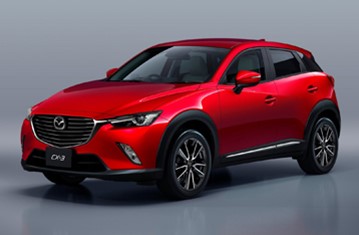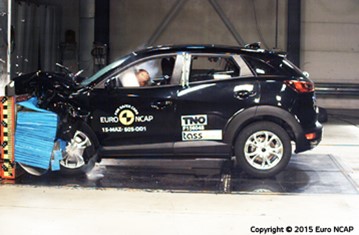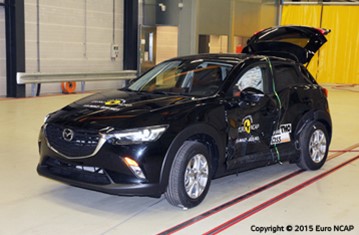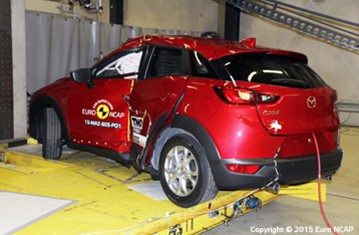Find more information in the General Comments section of the assessment
Find more information in the Rating Validity tab of the assessment
- See More
- See More
- See More
- See More
- Good
- Adequate
- Marginal
- Weak
- Poor
 Passenger
Passenger
 Driver
Driver
 Rear Passenger
Rear Passenger
 Driver
Driver
 Car
Car
 Pole
Pole
 Rear Seat
Rear Seat
 Front Seat
Front Seat
- Good
- Adequate
- Marginal
- Weak
- Poor


Passenger
outboard
center
Fitted to the vehicle as standard
Not fitted to the test vehicle but available as option
Not Available
-
Infants up to 13 kg
-
Infants and toddlers up to 18 kg
-
Toddlers from 9 to 18 kg
-
Toddlers over 18 kg
Easy
Difficult
Safety critical
Not allowed
| Seat Position | ||||
|---|---|---|---|---|
| Front | 2nd row | |||
| Passenger | Left | center | Right | |
| Maxi Cosi Cabriofix (Belt) | ||||
| Britax Römer King Plus (Belt) | ||||
| Britax Römer Duo Plus (ISOFIX) | ||||
| Britax Römer KidFix (Belt) | ||||
| Maxi Cosi Cabriofix & EasyFix (Belt) | ||||
| Maxi Cosi Cabriofix & EasyFix (ISOFIX) | ||||
| BeSafe iZi Kid X3 ISOfix (ISOFIX) | ||||
| Maxi Cosi Pearl & Familyfix (ISOFIX) | ||||
| Britax Römer KidFix (ISOFIX) | ||||
Easy
Difficult
Safety critical
Not allowed
The CX-3 scored maximum points for its protection of the 1½ year dummy in the dynamic impact tests. In the frontal test, forward movement of the 3 year dummy, sat in a forward-facing restraint, was not excessive. In the side impact, both child dummies were properly contained within the protective shells of their restraints, minimising the likelihood of head contact with parts of the car interior. The front passenger airbag can be disabled to allow a rearward facing child restraint to be used in that seating position. Clear information is provided to the driver regarding the status of the airbag and the system was rewarded. All of the restraint types for which the CX-3 is designed could be properly installed and accommodated in the car.
- Good
- Adequate
- Marginal
- Weak
- Poor

Head Impact 20.0 Pts
Pelvis Impact 4.3 Pts
Leg Impact 6.0 Pts
The bumper scored maximum points for its protection of pedestrians' legs, showing good results in all areas tested. However, protection of the pelvis region was mixed, with areas of good, poor and weak performance. The bonnet of the CX-3 performed well and results were good or adequate over almost the entire bonnet surface.
- Good
- Adequate
- Marginal
- Weak
- Poor
| System Name | Adjustable Speed Limiter |
| Speed Limit Information Function | N/A |
| Warning Function | Manually set |
| Speed Limitation Function | Manually set |
| System Name | DSC | |
| Performance | ||
| Vehicle Yaw Rate @ COS + 1.00 s | 3.3% | meets ECE requirements |
| Vehicle Yaw Rate @ COS + 1.75 s | 3% | meets ECE requirements |
| Lateral Displacement @ BOS + 1.07 s | 2.98 m | meets ECE requirements |
| Applies To | All seats | ||
| Warning | Driver Seat | Front Passenger(s) | Rear Passenger(s) |
| Visual | |||
| Audible | |||
|
|||
| System Name | LDWS |
| Type | Lane Departure Warning |
| Operational From | 70 km/h |
| Warning | Audible & Visual |
| Performance | |
|
LDW Confirmation Test
|
Pass |
Electronic stability control is standard equipment, as is a seatbelt reminder for the front and rear seats. A driver-set speed limiter is available as an option and is expected to be fitted to most cars sold as is a lane departure warning system. An autonomous emergency braking system for the speeds typical of highway driving is available as an option but is not expected to be fitted enough vehicles to qualify for assessment.
- Specifications
- Safety Equipment
- Videos
- Rating Validity
Specifications
Tested Model Mazda CX-3 2.0 'Core', LHD
Body Type - 5 door wagon
Year Of Publication 2015
Kerb Weight 1231kg
VIN From Which Rating Applies - all CX-3s
Class City and Supermini
Safety Equipment
Note: Other equipment may be available on the vehicle but was not considered in the test year.
Fitted to the vehicle as standard
Fitted to the vehicle as option
Not fitted to the test vehicle but available as option
Not Available
Not Applicable
Videos
Rating Validity









Find more information in the General Comments section of the assessment
 Share
Share











The passenger compartment of the CX-3 remained stable in the offset frontal impact. For the front passenger dummy, all critical body areas were well protected. Dummy readings indicated good protection of the knees and femurs for both the driver and passenger. Mazda showed that a similar level of protection would be provided to occupants of different sizes and to those sat in different positions. In the full-width frontal test, the driver passenger scored maximum points with good protection of all body areas. However, readings of chest compression in the rear passenger dummy indicated weak protection of that body region, despite the standard-fit seatbelt pre-tensioners and load-limiters in the rear seats. In the side barrier test, the CX-3 scored full points with good protection of all critical areas. Even in the more severe side pole impact, full points were scored. The front seats and head restraints provided good protection against whiplash injury in the event of a rear-end collision. However, a geometric assessment of the rear seats and restraints indicated poor whiplash protection for the occupants of these seats. A low-speed autonomous emergency braking system is available as an option. As it is not standard equipment, it did not qualify for inclusion in the assessment.